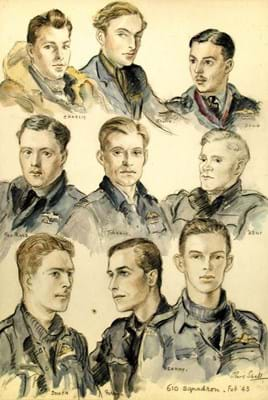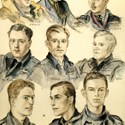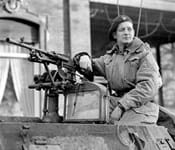Cheffins consultant John Foster said: “You have one chance in a generation to buy a diary like it. I had the opportunity to read it from cover the cover, and that alone was amazing.”
The handwritten leather-bound wartime diary from 1942 contained detailed entries of the everyday life – both domestic and RAF-related – of Wing Commander (later Air Vice-Marshal) James Edgar ‘Johnnie’ Johnson (1915-2001), CB, CBE, DSO and two bars, DFC and bar.
As is often the case, an earlier auction result had prompted the consignment. Cheffins had sold a portrait of Johnson by Leonard Harry Wells in January for a hammer price of £28,000, more than double the low estimate (see Art Market, ATG No 2277). The diary was from the same family source, consigned alongside a pair of evocative watercolour and charcoal drawings by Olive Snell showing the pilots of 610 Squadron in February 1943. With Johnson sketched among them, it made a mid-estimate £8000.
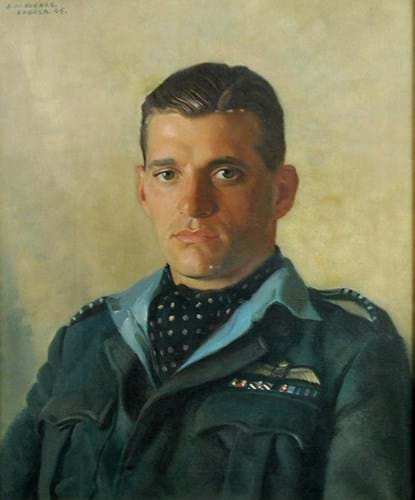
An oil portrait of Wing Commander James Edgar ‘Johnnie’ Johnson by Leonard Harry Wells sold by Cheffins in January for £28,000.
The buyer's view
The diary sold to collector Phil Mitzman, of Ely in Cambridgeshire, who had read about the consignment in The Times. He outbid two institutions and another private collector.
ATG: Are you a militaria and/or RAF collector?
PM: I am not. I am more a keen student of the Second World War in particular and modern military matters generally, but I don’t actually collect very much in the way of this. What I collect generally, strangely enough, are first edition books. I have a number of those and it is a fairly eclectic mix, but because of my military interest, when this diary came up I was absolutely fascinated by it and wanted very much to obtain it.
ATG: How did the bidding go?
PM: I really didn’t think I was going to get it because I thought the interest would be very substantial. Indeed, that’s how I picked up on it because it was in the Times and when I realised it was a local auction, at Cambridge, I decided to go and, as they say, when the music stopped I was holding the parcel. The diary is quite extraordinary and I sort of floated around for the rest of that weekend on a bit of a cloud.
ATG: How did your RAF interest start?
PM: I think it is because my initial interest in the Second World War in the first place when I was very young was with the RAF, and indeed I was going to be a pilot at 13-14. I actually went for pre-assessment and all sorts of stuff down at Biggin Hill, and I was planning to do that. But things got changed for various reasons along the way and I didn’t become a pilot.
However, consequently I’ve been interested all the way through, and although my interest is generally now in military matters I still have a great affection for the RAF. And various things keep happening over the years to strengthen that interest – for instance, our current business operates in Ely in ‘Lancaster Way Business Park’, an old RAF base from 1942-‘45. It’s not a very specific interest in that sense, rather more an eclectic interest, and I was just emotionally attracted to the diary is the best way to describe it.
ATG: What do you plan to do with the diary now?
PM: I’ve actually spoken to one of the people at the Imperial War Museum in Duxford and she said a curator would most certainly be interested in talking about it, and I’m waiting to hear back from them – I’ve suggested they may want to take it on a temporary loan and display it. Duxford is very close to Ely.
ATG: Did you also bid for the two Johnson-related paintings in the July 6 sale?
PM: I actually would have liked to have bought it all together to tell the story, in fact, I did start bidding for the paintings and I chickened out because I thought I can’t afford both, and was sure the diary would go for much more. I probably shouldn’t have - if I’d hung on I’d have got those as well. But there you go.
ATG: What is it like to own the diary?
PM: It is really extraordinary. I’ve been reading it through. Cheffins were very good, they provided a sort of rough transcription which has been very useful because although I have read a lot of it and would rather do directly, sometimes you have to refer to the transcription – not so much because of the technical stuff but the writing. His writing is extremely good overall, as you would expect from most people of that era (my writing is terrible!), but just occasionally you need to switch to the transcription.
The Johnson diary
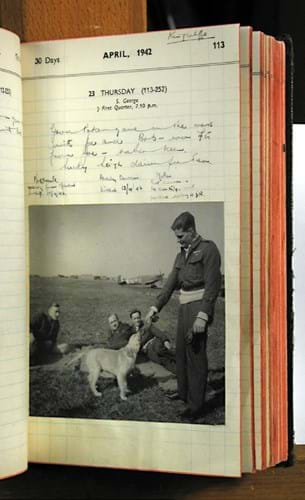
This page from Johnson’s diary includes a photo of him with Pusher, his dog, who was killed by a Motor Transport lorry. His second labrador Sally was to feature in several subsequent photos with Johnson and his Spitfire.
After an inauspicious start, Johnson got his first taste of combat in 1941 and quickly became indispensable, shooting down 34 enemy planes in total, although the overall count is likely to have been higher.
The year 1942 was, for Fighter Command, a year of transition. The Battle of Britain and the worst of the Blitz were now over and Luftwaffe resources were now concentrated on the Russian front.
Fighter Command’s main role was changing from one of destroying German bombers attacking Britain to escorting British, and latterly American, bombers attacking mainland Europe.
An example diary entry for Sunday, January 25, reads:
“Kirton: Flight arrived back from Garhill more dead than alive, made my report to Group Capt. Woolhams. In the evening Neville, Nip, Derek and I slipped down to the Royal and met old Nat, pushed along to The Jolly Sailor and had several more beers and the odd brandy.
“Lovely night with almost a full moon and Nip decided he was going to fly; tried to persuade him not but the bugger was very obstinate and moved quietly off in my van; rang up Kimby & told him to tell Nip that the CO’s instructions were not to take off, Dicky Stafford also refused him permission from opps – no use, he took off and after beating up the mess pranged when landing – stalled from about 20 feet.
“Hell of a row, CO talking about a court martial and the Nip walking about as white as a ghost.”


